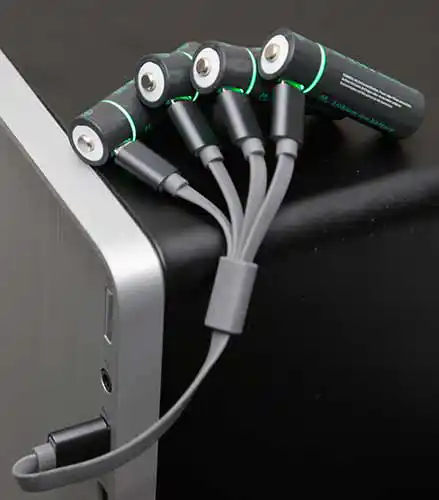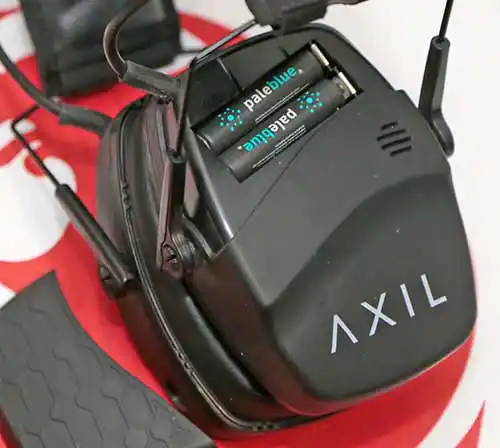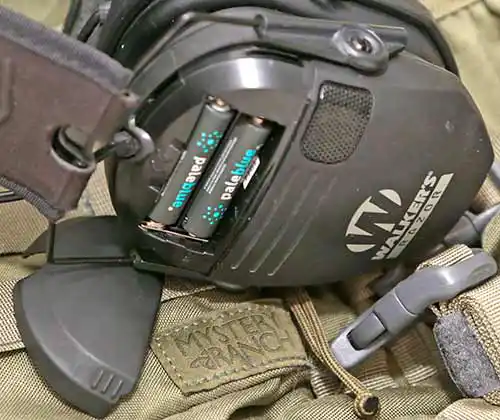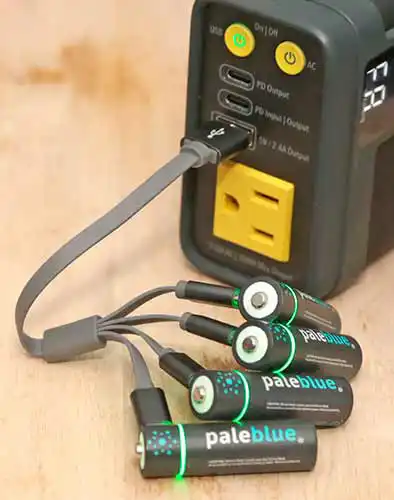My original article about Paleblue rechargeable batteries was nearly twice as long as this one. So I scrapped it. No one wants to be bored with a bunch of math and technical info. So I’ll cut to the chase here. Most outdoor enthusiasts should quickly realize the value of Paleblue rechargeable batteries. That’s because regardless of our interests, we should all be mindful of our impact on the environment. And we all need to acknowledge the importance of sustainability. I like to cite the Native American saying, “We do not inherit the Earth from our ancestors, we borrow it from our children.” If you enjoy the outdoors today, do your part so people can enjoy it tomorrow. It’s been a while since I got up on my soapbox, but meeting with the folks from Paleblue at a local tradeshow reminded me that I started this site as a platform for good. So here’s how we can do our part, and save money too.

Why Paleblue?
Paleblue batteries are rechargeable Lithium-ion. From a technical standpoint, they address the shortfalls of alkaline as well as NiMH (nickel metal hydride) batteries. Lower capacity NiMH batteries may get up to 1,000 recharges, if you’re willing to use a slower, overnight charger, which isn’t usually included. Higher capacity NiMH batteries will have about half that life. And this is for slow charging, not the typical five hour “quick” charging. Paleblue batteries charge in an hour. So more overall battery life, and less waiting. Factor in the added expense of the slow charger required to get the most life out of NiMH batteries, and Paleblue just keeps looking better.
On the subject of chargers, Paleblue batteries come in their own travel/storage case, with a charging cable, rather than a charger. That’s because the charging components are built right into the battery, along with a USB port. Their original batteries have micro USB micro ports, and the latest sport USB C ports. For the AA and AAA batteries, just connect four to the charging cable, and find a USB port or charger, which is nearly ubiquitous these days. They will flash green while charging, and turn to steady green once fully charged. Which happens in about an hour. They do need to be charged before their first use, but even then, it’s an hour or less, not five hours or overnight.

Single-use batteries are bad for your wallet as well as the environment
Alkaline batteries are not a good value for their relatively short life, compared to rechargeables. While they can theoretically be recycled, that’s neither common nor cost-effective. They’re made of non-renewable materials that aren’t all that valuable. And just because the EPA says you can put them in your household trash, that doesn’t mean you should. Although there are some use cases where an alkaline battery may be preferred or required (some medical devices and smoke detectors fall into that category), the majority of our applications are better served by rechargeables.
As a photographer, I have used the same supply of rechargeable AA batteries for at least six years now. That’s six years of not buying new batteries, and not throwing used ones away. As a recreational shooter, I haven’t been as good when it comes to AAA batteries. I’ve got several sets of electronic hearing protection which use AAA batteries. When I take people shooting, they sometimes forget to turn off their ears before throwing them back in the bag. So I would end up throwing money away on more batteries. Since I got these Paleblue rechargeable batteries to review, I haven’t purchased any more disposable AAA batteries. Once every few weeks or so, I pop them out, charge them, and they are good to go.

Our use of electronic devices is growing
Although alkaline batteries have been around for more than half a century, our use of battery-powered outdoor gear is a little more recent. A typical camping trip today might include LED lanterns, headlamps, and flashlights. Cyclists and hikers both rely on lighting as well as GPS. Other activities have their own specialized devices that are also fairly new. For recreational and competitive shooters, there’s electronic ear pro, shot timers, range finders, and even wind and weather meters. Although “There’s an app for that” holds true for a lot of things, we still have plenty of standalone gear that requires batteries.
Think about how many electronic gifts you’ll give or get this holiday season. And then think about the batteries they’ll need. Plenty of products out there have their own internal rechargeable batteries, which can be good and bad. But if they take AA, AAA, C, D, or 9V batteries, Paleblue has a solution. And with a warranty that covers 1,000 charges, they will pretty much last a lifetime.

But what if I don’t always have a charger handy?
Most of the time, we’re rarely more than a few feet from a USB port. Even outdoors, there are options. Unless you’re in Tristan da Cunha, a USB outlet isn’t far away. Most vehicles have one, or at least can easily be adapted to have one. If you really think your AA or AAA powered devices will require spare batteries on an outing away from outlets, then something like the Tough Tested BigFoot should be on your shopping list. It’s got a large internal battery, and charges via solar. For hiking and backwoods camping, this, and similar devices have enough capacity to keep your essentials topped up with minimal weight penalty. Because where there’s a will there’s a way.

Am I appealing to people watching their budget, or those that care about the environment?
Why not both? A typical AA alkaline battery costs about a dollar. That’s $4 for a four-pack. Yes, I wanted to avoid math, but here we are. A set of Paleblue AA batteries will set you back $29.99 plus tax. And you can charge them 1,000 times. If someone offered you 4,000 batteries for $30, would you take them? If someone told you that you could keep 4,000 batteries out of landfills for $30, would you do it? Of course, the answer is yes. And I’ll acknowledge that the up-front cost shouldn’t be taken lightly. But the more you use rechargeables, the quicker you will see the savings. While doing good for the environment.
Was there a review in here somewhere?
A battery review is a bit difficult. I don’t have any fancy testing gear, and I couldn’t find much relevance in seeing how many hours a Paleblue battery lasted in one of my flashlights. So I charged the batteries and put the AA ones in a high-drain device (camera flash), and the AAA ones in low-drain devices (ear pro). I’m getting short recycle times with them in a Canon 600EX-RT, and hours of protection across several brands of ear pro. If I continue to charge them at a rate of every 2-4 weeks, they’re only going to last for somewhere between 38 and 80 years. Next time, I should lead with that, and save you the trouble of reading. Find all the latest money-saving, environment-saving Paleblue battery options at paleblueearth.com.
I’d like to thank Paleblue for providing their batteries for my use and review. If you’d like to learn more about the company and their sustainability efforts, visit paleblueearth.com.